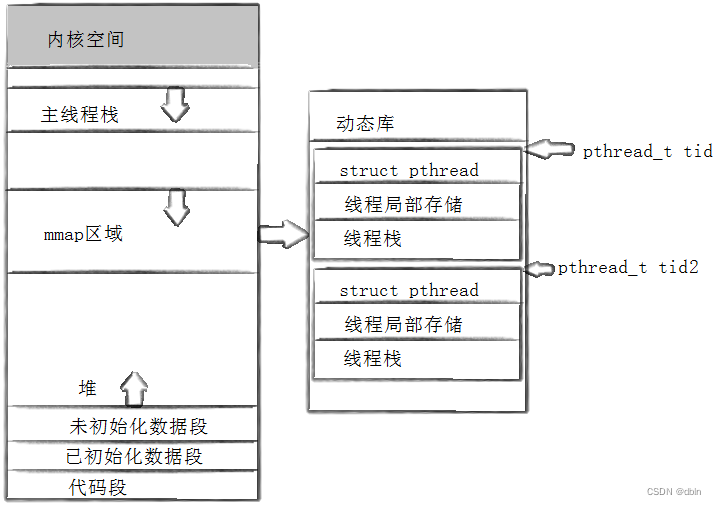Linux之线程控制
目录
一、POSIX线程库
二、线程的创建
三、线程等待
四、线程终止
五、分离线程
六、线程ID:pthread_t
1、获取线程ID
2、pthread_t
七、线程局部存储:__thread
一、POSIX线程库
由于Linux下的线程并没有独立特有的结构,所以Linux并没有提供线程相关的接口。
而我们所说的,pthread线程库是应用层的原生线程库。这个线程库并不是系统接口直接提供的,而是由第三方帮我们提供的。
1、与线程有关的函数构成了一个完整的系列,绝大多数函数的名字都是以“pthread_”打头的
2、要使用这些函数库,要通过引入头文<pthread.h>
3、链接这些线程函数库时要使用编译器命令的“-lpthread”选项
二、线程的创建
pthread_create:其功能就是创建线程。
NAMEpthread_create - create a new threadSYNOPSIS#include <pthread.h>int pthread_create(pthread_t *thread, const pthread_attr_t *attr,void *(*start_routine) (void *), void *arg);Compile and link with -pthread.参数说明:
thread:获取创建成功的线程ID,该参数是一个输出型参数。
attr:用于设置创建线程的属性,传入nullptr表示使用默认属性。(我们一般不关心,直接设为nullptr)
start_routine:该参数是一个函数指针,表示线程启动后要执行的函数。
arg:传给线程执行函数的参数。
返回值:线程创建成功返回0,失败返回错误码。返回值也可以自己设置,返回给主线程。主线程通过pthread_join获取。
主线程:当一个程序启动时,就有一个进程被操作系统创建,与此同时一个线程也立刻运行,这个线程就叫做主线程。
下面我们让主线程调用pthread_create函数创建一个新线程:
#include <iostream>
#include <unistd.h>
#include <pthread.h>using namespace std;void *thread_run(void *argc)
{cout << "new thread pid: " << getpid() << "\n"<< endl;sleep(20);return nullptr;
}int main()
{pthread_t tid;pthread_create(&tid, nullptr, thread_run, (void *)"thread 1");while (true){cout << "main thread pid: " << getpid() << endl;sleep(1);}return 0;
} 
使用ps -aL命令,可以显示当前的轻量级进程。

从上图,我们看到两个线程的PID相同,说明他们属于同一个进程。但是他们的LWP值不同,说明他们是两个不同的线程。LWP就是轻量级进程的ID。
注:在Linux中,线程与内核的LWP是一一对应的,实际上操作系统调度的时候是根据LWP调度的,而不是PID,只不过我们之前接触到的都是单线程进程,其PID和LWP是相等的,所以对于单线程进程来说,调度时采用PID和LWP是一样的。
我们也可以让一个主线程创建多个新线程
#include <iostream>
#include <unistd.h>
#include <string>
#include <pthread.h>using namespace std;void *thread_run(void *argc)
{string name = (char *)argc;while (true){cout << name << "---"<< "pid: " << getpid() << "\n"<< endl;sleep(1);}
}int main()
{pthread_t tid[5];char name[64];for (int i = 0; i < 5; i++){snprintf(name, sizeof(name), "%s-%d", "thread", i);pthread_create(tid + i, nullptr, thread_run, (void *)name);sleep(1);}while (true){cout << "main thread pid: " << getpid() << endl;sleep(3);}return 0;
}
因为主线程和五个新线程都属于同一个进程,所以它们的PID都是一样的。
三、线程等待
一个线程被创建出来,那么这个线程就如同进程一般,也是需要被等待的。如果主线程不对新线程进行等待,那么这个新线程的资源也是不会被回收的。如果不等待会产生类似于“僵尸进程”的问题,也就会造成内存泄漏。所以线程需要被等待。
pthread_join:其功能就是进行线程等待
NAMEpthread_join - join with a terminated threadSYNOPSIS#include <pthread.h>int pthread_join(pthread_t thread, void **retval);Compile and link with -pthread.参数说明:
thread:被等待线程的ID。
retval:线程退出时的退出码信息。
返回值:线程等待成功返回0,失败返回错误码。
#include <iostream>
#include <unistd.h>
#include <string>
#include <pthread.h>using namespace std;void *thread_run(void *argc)
{int count = 10;while (true){sleep(1);if (count++ == 10)break;}cout << "new thread done ... quit" << endl;return nullptr;
}int main()
{pthread_t tid;pthread_create(&tid, nullptr, thread_run, (void *)"thread1");pthread_join(tid, nullptr);cout << "main thread wait done ... quit" << endl;return 0;
}
第二个参数是用来获取新线程返回值的。主线程可以通过新线程的返回值拿到新线程的计算结果(该结果也可以保存在堆空间上)
include <iostream>
#include <unistd.h>
#include <string>
#include <pthread.h>using namespace std;void *thread_run(void *argc)
{int count = 10;while (true){sleep(1);if (count++ == 10)break;}cout << "new thread done ... quit" << endl;return (void *)10;
}int main()
{pthread_t tid;pthread_create(&tid, nullptr, thread_run, (void *)"thread1");void *ret = nullptr;pthread_join(tid, &ret);cout << "main thread wait done ... quit"<< " " << (long long)ret << endl;return 0;
}
四、线程终止
return:最简单的终止线程的方式,就是使用return返回一个返回值来终止线程。
pthread_exit:其功能就是终止一个线程。(终止线程不能使用exit,因为它是用来终止进程的)
参数,retval:设置退出结果。
NAMEpthread_exit - terminate calling threadSYNOPSIS#include <pthread.h>void pthread_exit(void *retval);Compile and link with -pthread.#include <iostream>
#include <unistd.h>
#include <string>
#include <pthread.h>using namespace std;void *thread_run(void *argc)
{int count = 10;while (true){sleep(1);if (count++ == 10)break;}cout << "new thread done ... quit" << endl;pthread_exit((void*)17);
}int main()
{pthread_t tid;pthread_create(&tid, nullptr, thread_run, (void *)"thread1");void *ret = nullptr;pthread_join(tid, &ret);cout << "main thread wait done ... quit"<< " " << (long long)ret << endl;return 0;
} 
pthread_cancel:其功能是取消一个线程。
参数,thread:线程ID。
NAMEpthread_cancel - send a cancellation request to a threadSYNOPSIS#include <pthread.h>int pthread_cancel(pthread_t thread);Compile and link with -pthread.#include <iostream>
#include <unistd.h>
#include <string>
#include <pthread.h>using namespace std;void *thread_run(void *argc)
{string name = (char *)argc;int count = 10;while (true){sleep(1);if (count++ == 10)break;}cout << "new thread done ... quit" << endl;
}int main()
{pthread_t tid;pthread_create(&tid, nullptr, thread_run, (void *)"thread1");void *ret = nullptr;pthread_cancel(tid);pthread_join(tid, &ret);cout << "main thread wait done ... quit"<< " " << (long long)ret << endl;return 0;
} 
线程被取消,线程等待时获取的退出码为-1。
五、分离线程
新线程退出后,主线程需要对其进行pthread_join操作,否则无法释放资源,从而造成内存泄漏。
但如果主线程不关心新线程的返回值,此时我们可以将该新线程进行分离,后续当新线程退出时就会自动释放线程资源。
一个线程如果被分离了,这个线程依旧要使用该进程的资源,依旧在该进程内运行,甚至这个线程崩溃了一定会影响其他线程,只不过这个线程退出时不再需要主线程去join了,当这个线程退出时系统会自动回收该线程所对应的资源。
pthread_detach:其功能就是进行分离线程。一般是线程自己分离。
int pthread_detach(pthread_t thread);参数说明:thread:被分离线程的ID。
返回值说明:
线程分离成功返回0,失败返回错误码。
#include <iostream>
#include <unistd.h>
#include <string>
#include <pthread.h>using namespace std;void *thread_run(void *argc)
{pthread_detach(pthread_self());int count = 10;while (true){sleep(1);if (count++ == 10)break;}cout << "new thread done ... quit" << endl;pthread_exit((void*)17);
}int main()
{pthread_t tid;pthread_create(&tid, nullptr, thread_run, (void *)"thread1");void *ret = nullptr;cout << "main thread wait done ... quit"<< " " << (long long)ret << endl;return 0;
}
如果我们在线程分离了之后,任然等待,会怎么样呢?
#include <iostream>
#include <unistd.h>
#include <cerrno>
#include <cstring>
#include <pthread.h>using namespace std;void *thread_run(void *argc)
{pthread_detach(pthread_self());int count = 9;while (true){sleep(1);if (count++ == 10)break;}cout << "new thread done ... quit" << endl;pthread_exit((void *)17);
}int main()
{pthread_t tid;pthread_create(&tid, nullptr, thread_run, (void *)"thread1");sleep(2);int n = pthread_join(tid, nullptr);cout << "n: " << n << "errstring: " << strerror(n) << endl;return 0;
}
六、线程ID:pthread_t
pthread_create函数会产生一个线程ID,存放在第一个参数指向的地址中,该线程ID和内核中的LWP是完全不一样的。内核中的LWP属于进程调度的范畴,需要一个数值来唯一表示该线程。
那么pthread_t到底是什么类型呢?
1、获取线程ID
pthread_self:获取线程的ID。
#include <iostream>
#include <unistd.h>
#include <cerrno>
#include <cstring>
#include <pthread.h>using namespace std;void *thread_run(void *argc)
{int count = 9;while (true){sleep(1);if (count++ == 10)break;}cout << "new thread done ... quit"<< "new thread ID: " << pthread_self() << endl;pthread_exit((void *)17);
}int main()
{pthread_t tid;pthread_create(&tid, nullptr, thread_run, (void *)"thread1");void *ret = nullptr;sleep(2);cout << "main thread ID: " << pthread_self() << endl;pthread_join(tid, &ret);return 0;
}
为什么线程的ID数值这么大呢?下面我们就来讲一讲。
2、pthread_t
进程运行时线程动态库被加载到内存,然后通过页表映射到进程地址空间中的共享区,此时该进程内的所有线程都是能看到这个动态库的。

其中主线程采用的栈是进程地址空间中原生的栈,而其余线程采用的栈就是由线程库帮我们在共享区中开辟的。
线程库给每个新线程提供属于自己的struct pthread,当中包含了对应线程的各种属性;每个线程还有自己的线程局部存储,当中包含了对应线程被切换时的上下文数据。其中,还有线程栈。如下图:

所以,线程ID本质就是进程地址空间共享区上对应的struct pthread的虚拟地址。
七、线程局部存储:__thread
假设有一个全局变量:g_val。我们知道,各个线程是共享全局变量的。不同的线程可以对同一个全局变量进行操作。那么如果我们想让每个线程都拥有属于自己的g_val,那么我们可以加上关键字:__thread。这种现象就叫做线程局部存储。
